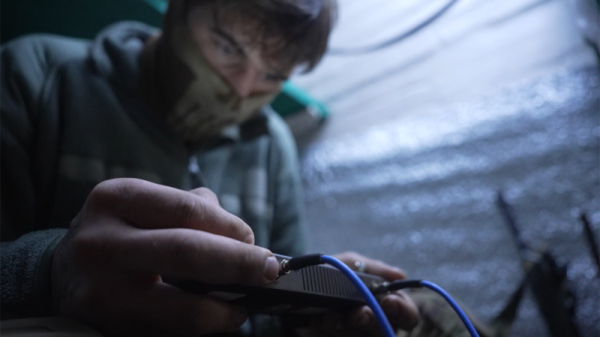When observing a hoard of golden-backed frogs at a roadside pond in Karnataka, India, a group of naturalists noticed something odd about one of the amphibians — the animal had a tiny mushroom sprouting out of its side.
How the seemingly healthy frog came to grow its fungi companion — an occurrence that’s never been documented before — has left scientists baffled, according to a note published in January in the journal Reptiles and Amphibians.
“When I first observed the frog with the mushroom, I was amazed and intrigued by the sight,” said Lohit Y T, a rivers and wetlands specialist with World Wildlife Fund-India in Bengaluru, via email. Y T was a part of the group that discovered the frog. “My thought was to document it, as this phenomenon is something we have never heard of. We just wanted this to be a rare incident and not a dangerous phenomenon for the frog.”
The species — known as Rao’s intermediate golden-backed frog, or the scientific name Hylarana intermedia — is found in abundance in the southwestern Indian states of Karnataka and Kerala. The frogs are small, growing to be only up to 2.9 inches (7.4 centimeters) in length.
As the naturalists watched the frog with the fungal growth, the animal moved from the center of the twig it sat upon to the very tip, turning around and changing positions, but the mushroom remained perfectly in place, Y T said. The group did not touch the frog.
The authors discovered the amphibian in June 2023 and did not collect it, so neither the cause of the phenomenon nor the fate of the frog is known.
But through pictures, mycologists later identified the mushroom growing out of the frog’s flank as a common bonnet, part of the Mycena genus, a type of fungi that mostly grows on rotting wood from dead trees, the authors wrote in the published paper. The fungus is a saprotrophic decomposer, a mushroom that typically gets its nutrients from dead or decaying organic matter — but a 2023 study found the mushroom could evolve to thrive on living plants as well.
The 2023 study further suggested that the Mycena fungus could develop to have a symbiotic relationship with living plants or trees, meaning that both the plant and the fungus growing on it would benefit from the arrangement — the fungi would both take nutrients from and transfer them to the plant host. In trees, Mycena could be helpful by pruning dead branches, the authors added.
The prognosis of the frog with the mushroom hitchhiker is unknown, but there are a handful of theories as to the cause of its condition.
Fate of the mushroom frog
Upon first seeing the report of the frog with a mushroom attached to its flank, Alyssa Wetterau Kaganer, a postdoctoral associate in the department of public and ecosystem health at the Cornell University College of Veterinary Medicine, found the discovery fascinating.
Invasive Jorō spider is surprisingly tolerant of busy urban settings, according to new study
“Fungi are dynamic organisms that adapt to changes in their environment, and with exposure to new potential hosts in different environments or climates they may grow in places we hadn’t previously expected,” she said in an email.
While it is difficult to predict the fate of the frog without further study of its condition, it is possible that “an otherwise healthy frog may be able to withstand mild colonization of its skin by this fungus without any adverse health effects,” Kaganer said. Fungal infections in frogs are very common, however, and if the mushroom were to “grow extensively on the skin or burrow within the animal’s body, the animal may develop signs of a fungal disease,” she added. Kaganer was not involved with the discovery.
There are many types of fungi that can infect frogs, and it is possible there are fungus-frog interactions yet to be discovered. A frog with signs of fungal disease, such as “altered behavior of the frog” or “skin damage including ulceration or tumor-like nodules,” has an infection that can often result in death for at least some of the infected animals, Kaganer said.
Tiny fish can make noises louder than an elephant, says new study
Anything out of the ordinary, including a fungal growth like this, is of concern for frog species, said Karthikeyan Vasudevan, chief scientist for the Laboratory for the Conservation of Endangered Species at the Centre for Cellular and Molecular Biology in Telangana, India. Vasudevan was not involved with the discovery and was also surprised by the find.
“Sick animals in the wild have very little chance of survival. To notice a sick animal is difficult, as they die or get eaten up quickly. Therefore, something like this is interesting and should be followed up with observations and screening of frogs,” Vasudevan said in an email.
Initially, Vasudevan had thought the mushroom was stuck on the frog’s skin rather than a growth, but photos of the critter convinced him otherwise. “It is indeed the case of a live mushroom on a live frog,” Vasudevan said. “But one of the possibilities is that there is a small piece of woody debris under the skin of the frog after it got lodged in the skin and it has sprouted a mushroom from it.”
Chytrid disease caused by fungus
India is currently facing an epidemic of a frog-killing disease known as chytridiomycosis, a fungal infection that affects more than 700 species of amphibians worldwide. The disease has been observed in low levels in all the frog hotspots across India, the authors of the new note wrote.
Chytrid disease is an example of a common amphibian and fungi interaction. But the authors do not know whether it is related to this discovery, Y T said.
“This specific type of mushroom is not closely related to the species of fungus that cause chytridiomycosis, so I am not concerned that this mushroom is a direct sign of chytridiomycosis,” said Kaganer, who studies the disease. “However, it is possible that a frog with Mycena might have altered susceptibility to a chytrid infection.”
Giant chicken frog faces extinction due to a deadly amphibian fungus
The frog with the mushroom in its side could either have an increase in susceptibility to chytridiomycosis from being compromised by the Mycena, or it could be more immune “because the Mycena has kicked the frog’s immune system into high gear,” she added.
“We don’t have any hope of pursuing the frog, as this is not a common phenomenon,” Y T said. The authors will visit the spot again during the next monsoon season, when the weather is warm and rainy and the frogs are most abundant, he added.
“If we manage to find it, it’ll be great,” Y T said. “The spot has been frequented by many enthusiasts and experts alike. It would be great if some researcher gets their hands on it and can further the investigation, but again, it’s all highly unlikely to happen.”







































